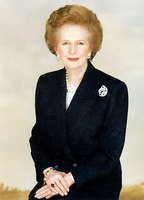Third Thatcher ministry
| Third Thatcher ministry | |
|---|---|
| 87th ministry of the United Kingdom (since 1707) | |
| 1987–1990 | |
 |
|
| Date formed | 11 June 1987 |
| Date dissolved | 27 November 1990 |
| People and organisations | |
| Head of government | Margaret Thatcher |
| Deputy head of government | The Viscount Whitelaw (1987–88) Sir Geoffrey Howe (1989–90) |
| Head of state | Queen Elizabeth II |
| Member party | Conservative Party |
| Status in legislature | Majority |
| Opposition cabinet | Kinnock Shadow Cabinet |
| Opposition party | Labour Party |
| Opposition leader | Neil Kinnock |
| History | |
| Election(s) | 1987 general election |
| Predecessor | Second Thatcher ministry |
| Successor | First Major ministry |
Margaret Thatcher was Prime Minister of the United Kingdom from 4 May 1979 to 28 November 1990, during which time she led a Conservative government. She was the first woman to hold that office. During her premiership, Thatcher moved to liberalise the British economy through deregulation, privatisation, and the promotion of entrepreneurialism. This article details the Third Thatcher ministry, which existed from 1987 until 1990.
The 'Tories' were elected for a third successive term in June 1987, with a majority of 102 seats. It enabled prime minister Margaret Thatcher to become the longest-serving prime minister of the 20th century, as Britain's economic recovery continued.
With the battle against inflation and strikes long won, an economic boom was in its early stages. Unemployment had fallen below 3,000,000 during the spring of 1987, and the tax cuts by chancellor Nigel Lawson sent the economy into overdrive. By early 1988, unemployment was below 2,500,000. A year later, it fell below 2,000,000. By the end of 1989, it was down to 1,600,000. A residential property price surge saw the average home price in Britain double between 1986 and 1989.
However, this led to the government doubling interest rates during 1988 and it chose to increase these further during 1989 and 1990 as inflation increased.
As early as September 1988, economists were warning that the economic boom would soon be over and that 1989 could see a recession set in. However, the economy continued to defy these predictions and it continued to grow throughout 1989 and unemployment continued to fall, despite several other world leaders – namely the United States of America – entering recession that year.
By the end of the 1980s employment was booming above all in the financial and retail sectors – particularly on new commercial developments that were built on old industrial sites. For instance the Merry Hill Shopping Centre in the West Midlands saw 6,000 retail jobs created between 1984 and 1989 on an old steelworks site which had shed just over 1,200 jobs when it closed in 1982. The comparable MetroCentre was built at Gateshead, Tyne and Wear, around the same time.
...
Wikipedia
